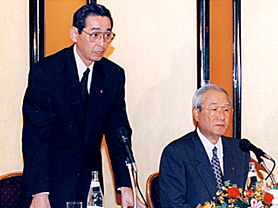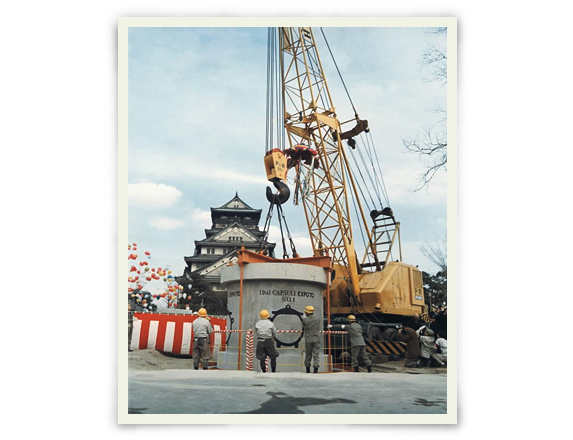2000
Kunio Nakamura Assumes the Position of President
As the year 2000 ushered in the new millennium, the progressing IT revolution made for fundamental changes in the structure of industry and lifestyles the world over. Even in the electronics industry, mergers and acquisitions that traversed corporate groups and crossed national borders were occurring at a fever pitch and the race to build competitiveness intensified. As greater speed became an expectation for all companies, the 20th century-style corporate model was now being replaced with a 21st century version.
Amid this transition, Senior Managing Director Kunio Nakamura assumed the position of Panasonic president in June 2000. Meanwhile, President Morishita moved on to the position of chairman, Chairman Masaharu Matsushita assumed the role of honorary chairman, and Vice President Masayuki Matsushita took on the role of vice chairman.

President Nakamura offering remarks at the press conference marking the start of his term as president
Right after assuming his new position, at the management conference President Nakamura unveiled the “5 Ss” of his management style: speed, simplicity, strategy, sincerity, and smile. Speaking about a “21st century-style ‘Super Manufacturing Company’” that makes the most of the benefits of IT, he also stressed the need for all levels of the company and all employees to shift to a “flat & web style organizational structure” in which customers are dealt with directly.
In July, a new “IT Innovation Division” was established for the purpose of accelerating and strengthening innovation that establishes a customer-direct-style management structure utilizing information technology. President Nakamura assumed the role of division director to lead the effort.
In November 2001, the outline of the three-year management plan the “Value Creation 21 Plan” was announced. The true aim of the plan was “Deconstruct & Create” (the implementation of Groupwide structural reform and Groupwide growth strategy) as we innovated to become a “Super Manufacturing Company” and to recreate ourselves as a new Panasonic capable of continuing to make contributions to society in the 21st century as well. Moreover, numerical targets for FY2003 were set for (1) profitability (group operating profit rate of 5% or more), (2) capital profitability (CCM (capital cost management) of 0 or more), and (3) growth (consolidated net sales of 9 trillion yen).
A Time Capsule Is Opened for the First Time in 30 Years

One of the two Expo ’70 Time Capsules made to commemorate the Osaka Expo in 1970 was opened for the first time in 30 years in March 2000.
The time capsules are intended for leaving to mankind 5,000 years into the future contained 2,098 items that had been specially selected as cultural artifacts as of 1970. Created out of a collaboration between Panasonic and The Mainichi Newspapers, the time capsules had been buried in Osaka Castle Park.
There are two time capsules with identical content, one buried 10 meters deep underground, the other 15 meters. The time capsule unearthed this time, the one buried 10 meters underground, was to be inspected in the year 2000 and then once a century thereafter. The other time capsule is to be opened in the year 6870.
Of the 2,098 items in the time capsule unearthed, 173 items were inspected. Though some of the bacteria samples had perished, the rice cooker and television set worked normally. In addition, the experimental plant seeds had sprouted and most of the other items had been kept in the same state and working condition they were in when first placed in the capsule.
After the inspection completed, the capsule was buried again in November. The next time it will be opened and inspected is the year 2100.